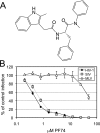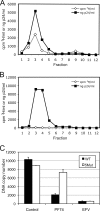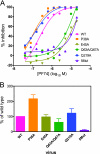Small-molecule inhibition of human immunodeficiency virus type 1 infection by virus capsid destabilization
- PMID: 20962083
- PMCID: PMC3014163
- DOI: 10.1128/JVI.01406-10
Small-molecule inhibition of human immunodeficiency virus type 1 infection by virus capsid destabilization
Abstract
Human immunodeficiency virus type 1 (HIV-1) infection is dependent on the proper disassembly of the viral capsid, or "uncoating," in target cells. The HIV-1 capsid consists of a conical multimeric complex of the viral capsid protein (CA) arranged in a hexagonal lattice. Mutations in CA that destabilize the viral capsid result in impaired infection owing to defects in reverse transcription in target cells. We describe here the mechanism of action of a small molecule HIV-1 inhibitor, PF-3450074 (PF74), which targets CA. PF74 acts at an early stage of HIV-1 infection and inhibits reverse transcription in target cells. We show that PF74 binds specifically to HIV-1 particles, and substitutions in CA that confer resistance to the compound prevent binding. A single point mutation in CA that stabilizes the HIV-1 core also conferred strong resistance to the virus without inhibiting compound binding. Treatment of HIV-1 particles or purified cores with PF74 destabilized the viral capsid in vitro. Furthermore, the compound induced the rapid dissolution of the HIV-1 capsid in target cells. PF74 antiviral activity was promoted by binding of the host protein cyclophilin A to the HIV-1 capsid, and PF74 and cyclosporine exhibited mutual antagonism. Our data suggest that PF74 triggers premature HIV-1 uncoating in target cells, thereby mimicking the activity of the retrovirus restriction factor TRIM5α. This study highlights uncoating as a step in the HIV-1 life cycle that is susceptible to small molecule intervention.
Figures





Similar articles
-
Roles of Capsid-Interacting Host Factors in Multimodal Inhibition of HIV-1 by PF74.J Virol. 2016 May 27;90(12):5808-5823. doi: 10.1128/JVI.03116-15. Print 2016 Jun 15. J Virol. 2016. PMID: 27076642 Free PMC article.
-
Cell Type-Dependent Escape of Capsid Inhibitors by Simian Immunodeficiency Virus SIVcpz.J Virol. 2020 Nov 9;94(23):e01338-20. doi: 10.1128/JVI.01338-20. Print 2020 Nov 9. J Virol. 2020. PMID: 32907979 Free PMC article.
-
PF74 Reinforces the HIV-1 Capsid To Impair Reverse Transcription-Induced Uncoating.J Virol. 2018 Sep 26;92(20):e00845-18. doi: 10.1128/JVI.00845-18. Print 2018 Oct 15. J Virol. 2018. PMID: 30089694 Free PMC article.
-
HIV Capsid Inhibitors Beyond PF74.Diseases. 2019 Oct 30;7(4):56. doi: 10.3390/diseases7040056. Diseases. 2019. PMID: 31671622 Free PMC article. Review.
-
HIV-1 Maturation: Lessons Learned from Inhibitors.Viruses. 2020 Aug 26;12(9):940. doi: 10.3390/v12090940. Viruses. 2020. PMID: 32858867 Free PMC article. Review.
Cited by
-
Cyclophilin A stabilizes the HIV-1 capsid through a novel non-canonical binding site.Nat Commun. 2016 Mar 4;7:10714. doi: 10.1038/ncomms10714. Nat Commun. 2016. PMID: 26940118 Free PMC article.
-
Capsid-Dependent Host Factors in HIV-1 Infection.Trends Microbiol. 2017 Sep;25(9):741-755. doi: 10.1016/j.tim.2017.04.004. Epub 2017 May 18. Trends Microbiol. 2017. PMID: 28528781 Free PMC article. Review.
-
HIV-1 Gag as an Antiviral Target: Development of Assembly and Maturation Inhibitors.Curr Top Med Chem. 2016;16(10):1154-66. doi: 10.2174/1568026615666150902102143. Curr Top Med Chem. 2016. PMID: 26329615 Free PMC article. Review.
-
Comparison of Biochemical Properties of HIV-1 and HIV-2 Capsid Proteins.Front Microbiol. 2017 Jun 13;8:1082. doi: 10.3389/fmicb.2017.01082. eCollection 2017. Front Microbiol. 2017. PMID: 28659897 Free PMC article.
-
Pharmacologic hyperstabilisation of the HIV-1 capsid lattice induces capsid failure.Elife. 2024 Feb 13;13:e83605. doi: 10.7554/eLife.83605. Elife. 2024. PMID: 38347802 Free PMC article.
References
-
- Blair, W. S., J. Isaacson, X. Li, J. Cao, Q. Peng, G. F. Kong, and A. K. Patick. 2005. A novel HIV-1 antiviral high throughput screening approach for the discovery of HIV-1 inhibitors. Antivir. Res. 65:107-116. - PubMed
-
- Blair, W. S., C. Pickford, S. L. Irving, D. G. Brown, M. Anderson, R. Bazin, J. Cao, G. Ciaramella, J. Isaacson, L. Jackson, R. Hunt, A. Kjerrstrom, J. A. Nieman, A. K. Patick, M. Perros, A. D. Scott, K. Whitby, H. Wu, and S. L. Butler. 2010. HIV capsid is a tractable target for small molecule therapeutic intervention. PLoS Pathog. 6:e1001220. - PMC - PubMed
Publication types
MeSH terms
Substances
Grants and funding
LinkOut - more resources
Full Text Sources
Other Literature Sources
Medical

